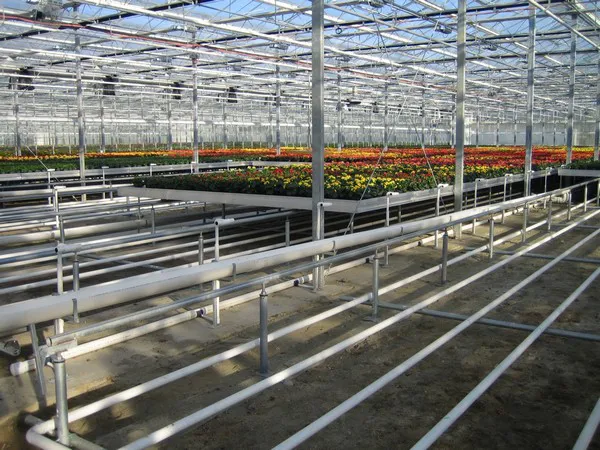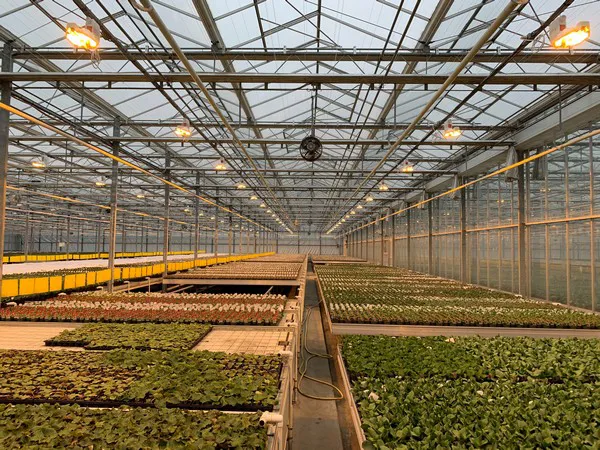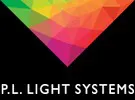Greenhouses are increasingly trying to become more energy efficient, with energy loads such as lighting, heating and cooling, and other environmental parameters becoming more expensive. One way to achieve greater energy efficiencies, is through upgrading your lighting system and designing a lighting plan that maximizes your light output― while saving you money.
Burnaby Lake Greenhouses, a 3rd generation grower of ornamentals and potted plants in Surrey, British Columbia, did just that with their new lighting retrofit. In replacing their old luminaires, they achieved greater energy and lighting efficiencies, and superior plant growth, with a short payback period of less than a year.

"We got the opportunity to talk with Maintenance Manager, Kelvin Van Eyk, on the retrofit, costs savings and overall improvement in plant growth they attained from replacing the old PL Lights Systems 600W PL2000s with the new 1000W NXT2s with Alpha Reflectors," says Jillian Whitehead, digital marketing specialist at P.L. Light Systems.
Since they grow a variety of plants that require high light intensities, supplemental lighting is key to the success of their business. He said, their first goal with the retrofit, was to begin by increasing the light intensity where the potted roses are grown.
The original 600W luminaires were only able to emit 80µmol of light, and the high light requirements of roses meant they were needing to add about 25µmol more (for a total of 105µmol) to grow the best roses possible in Vancouver’s wet and cold winter months. Before beginning the retrofit, they tested a small trial area with twelve NXT2 luminaires. The new NXT2’s exceeded their expectations and they saw improved growth, uniformity and performance than with the previous 600W luminaires.
With the new luminaires going above and beyond their expectations, they began the conversion of their greenhouses in 2017, switching out 360 of the 600W luminaires with only 150 1000W NXT2s. This new retrofit meant they needed 50% fewer lights than the original installation (thanks to the improvement in the NXT2’s design), resulting in higher light intensities and distribution. With the new NXT2 luminaires, they achieved a 25% increase in light levels compared to the old PL2000s.
In addition, they used 53% less power as the NXT2’s (with high efficiency electronic ballasts) use only 150kW versus the old PL 2000s (with magnetic ballasts) that used 216kW. This saved them approximately $144 a day in electrical costs, with a payback period of 348 days – less than a year.

Another feature they liked, is that the new NXT2s have an instant start-up with no warmup or cool down period compared to the old lights, and they find them more tolerant to voltage changes. In addition, they are saving more money because of the lower maintenance costs associated with the NXT2.
This is important because the growers keep supplemental lighting on almost 365 days a year with an average of 16 hours a day – this number goes up to about 20-22 hours in the winter months and down to about 8 hours during the summer months. After seeing the great results in their rose finishing greenhouse, Burnaby Lake has further retrofitted their rose staging area with the same 1000W NXT2 lights, increasing their light output from 60µmol to 105µmol and they plan to retrofit more of their greenhouses over the coming years.
Burnaby Lake Greenhouses is dedicated to environmental sustainability, so before installing the NXT2’s they wanted to trial some LEDs as well, since LEDs are known to be more energy efficient. However, after the initial trial they discovered the spectrum emitted by LEDs they trialed was too specific for growing roses.
Since they grow many different varieties of roses, all having different lighting requirements, they found some grew well and some did not - therefore, they couldn’t justify installing LEDs – especially since they saw such great results from the NXT2 HPS luminaires. In addition, they achieved better light penetration with the NXT2s, and decreased heating costs in the winter due to the radiant heat emitted by the HPS luminaires compared to the LEDs.
Overall Burnaby Lake Greenhouses is excited by what they’re seeing in the greenhouse with the new luminaires. They have achieved greater light levels while consuming less energy and most importantly are seeing improved results in plant growth and performance.
For more information:
P.L. Light Systems
Jillian Whitehead
Digital Marketing Specialist
www.pllight.com
